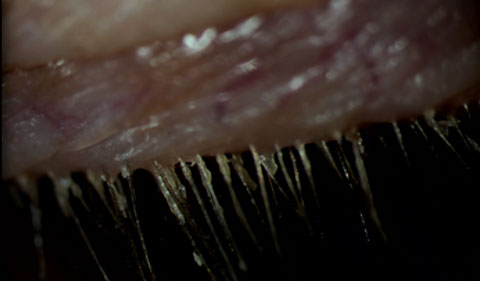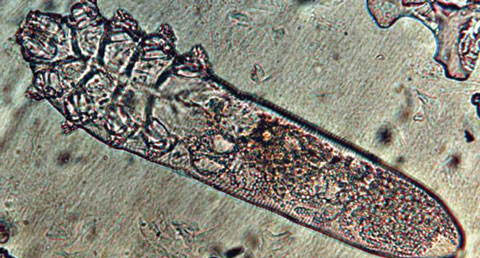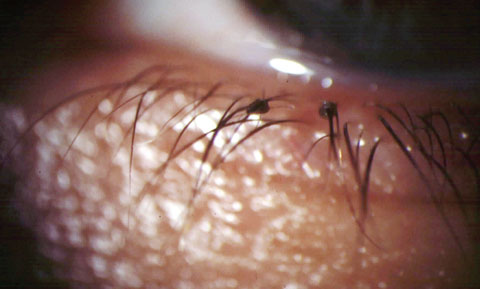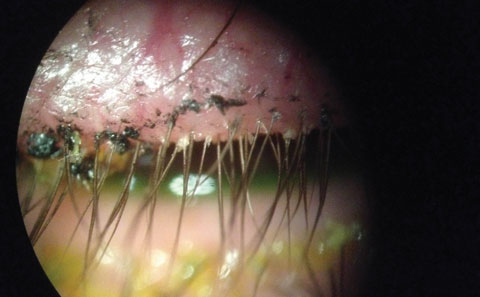Demodex management may be dismissed by some as a mere “fad” in optometric practice, but with more and more patients reporting refractory dry eye symptoms, it’s time to consider it an actual ocular concern that can impact any patient, especially those older than 50.1 Demodex is typically not difficult to manage, but its treatment in optometric offices remains uncommon. The majority of Demodex patients have mild to moderate symptoms that include itching and burning of the eyes and lids, foreign body sensation and fluctuating blurry vision.1-5 These symptoms can be swiftly managed with artificial tears, but if Demodex is the culprit, artificial tears will offer only temporary relief. As symptoms are similar to ocular surface disease, it is easy to assume dry eye syndrome and prescribe over-the-counter artificial tears rather than evaluate for the contributing factor, Demodex.
This article urges doctors to consider this diagnosis while explaining how to differentiate between Demodex and other causes of dry eye symptoms.
 |
| Cuffing, seen here, is a classic symptom of Demodex overpopulation, which can lead to dry eye symptoms that artificial tears simply can’t address. |
Meet the Mites
More than 100 species of Demodex mites have been identified.6 Demodex folliculorum and Demodex brevis are the two main species that inhabit the human skin. D. folliculorum typically range from 0.3mm to 0.4mm long and tend to reside within the hair follicles while D. brevis mites are about half the length (0.186mm) and reside within the sebaceous and meibomian glands.3,4,7
Both parasites are half the diameter of a grain of table salt and worm-shaped with four legs. D. folliculorum consume and damage epithelial cells at the hair follicle, resulting in a weakened lash root and the eventual loosening and misdirection of the lash.3,5,7 Their appendages create microabrasions that cause epithelial hyperplasia and reactive hyperkeratinization, which we see as cylindrical dandruff. D. brevis, on the other hand, tend to burrow deep into the sebaceous glands, physically blocking the orifice.5,7 In addition, its chitinous exoskeleton acts as a foreign body, inducing granulomatous reactions that can lead to hordeola or chalazia.5-7 Due to the D. brevis’ proximity to the ocular surface, it is more likely the cause of refractory corneal lesions than D. folliculorum.6
Under scrutiny of a slit lamp, D. folliculorum can sometimes be seen orienting themselves face down toward the follicle bed with a small portion of their tail protruding from the opening. Though more difficult, rotating the lash (without epilation) has also been effective in encouraging mites to travel to the follicle opening for easier observation behind a slit lamp.8
For those with easy access to a microscope, the presence of Demodex can also be enhanced with the addition of fluorescein or alcohol on the glass slide; they cause the cylindrical dandruff to become semitransparent to reveal mites hiding within the debris.3 Due to their photosensitivity, Demodex tend to avoid the bright lights and can be difficult to observe under plain biomicroscopy. For the same reason, most mating and movement occurs at night. Their lifespan is about one to two weeks for adults.3-6
Patients may note increased lid irritation first thing in the morning as a result of the increased activity at night.
The Pros and Cons of Demodex Therapies | ||
| Product | Pros | Cons |
| Avenova (Novabay) | • No stinging sensation • Proven effective against Demodex despite not containing active tea tree oil • three year shelf life | • Only available through prescription • Not covered by all insurers |
| BlephEx (RySurg) | • Disposable, rotating microsponge • Mechanical removal of lid debris via a handheld device • Performed in clinic by OD or staff | • Requires patient compliance • Frequent return visits to office • Patients currently need to pay out of pocket |
| Cliradex, Cliradex Complete, (Bio-Tissue) | • Comes with a microexfoliator for in-office use for cases with severe debris to allow better penetration of T4O • High concentration Cliradex Advanced Care gel (50% T4O) in Cliradex Complete Kit for in-office use allows more effective initial dose • Lower concentration (10% T4O) for home maintenance between visits • Lid scrubs available OTC for mild to moderate cases | • Strong menthol-like sensation (can be described as a stinging sensation) |
| Eye Eco Tea Tree Oil Eyelid & Facial Cleanser (Eye Eco) | • 2-in-1 face and lid wash • An effective make-up remover • Foam dispensing bottle • Available OTC | • Strong menthol-like sensation (can be described as a stinging sensation) • Removal of accumulated debris depends on patient’s attention to lids while applying |
| Ocusoft Lid Scrub (Ocusoft) | • Available in lid scrub pads or a foam to be used with a cotton applicator • Contains active tea tree oil ingredients • Removes debris and excessive oils • Available OTC | • Strong menthol-like sensation (can be described as a stinging sensation) |
| SteriLid (Theratears) | • Contains tea tree oil ingredients • Removes accumulated debris and excessive oils from lid margin • Available OTC | • Detergent-based product |
| Blephadex lid scrubs (Lunovus) | • Available in lid scrub pads or a foam to be used with a cotton applicator • Contains tea tree oil ingredients • Removes accumulated debris and excessive oils from lid margin • Available OTC | • Strong menthol-like sensation (can be described as a stinging sensation) |
| Baby Shampoo | • Cost efficient • Will address any bacterial component of blepharitis • No stinging sensation | • Typically no tea tree oil |
Invasion of the Body Snackers
Because these ectoparasites are susceptible to desiccation, they require a host to survive.6 In addition, the mite population increases with age.1,3,4,6,7,9 An overpopulation of mites can lead to an imbalance of tear cytokine levels, particularly an influx of interleukin 17, which is proinflammatory, leading to blepharitis.8,10 A recent study found that 84% of those older than age 60 have Demodex, and 100% of those older than 70 are infested.4 Several studies found that the average healthy patient will likely have a small population of Demodex, but also confirmed a marked increase (two to six mites infesting each follicle) in mite population in patients older than 50.6 One study found an average count of 12.9 mites per patient seen with cylindrical dandruff, whereas those without had an average of 0.35 mites—that’s a considerable difference.7 Individuals with compromised immune systems, such as those with poor systemic health and those taking immunosuppressive agents, have a higher level of Demodex, although contradicting research postulates that mites may thrive better in healthy, normal tears as opposed to tear deficient states.3
 |
| This microscopic image shows a Demodex folliculorum mite. While they can likely be found in everybody, an overpopulation of these critters can cause ocular discomfort and require targeted treatment. Photo: Joseph Shovlin, OD. |
Interestingly, a 2014 study based the presence of Demodex on amplification of Demodex DNA rather than visual observation.11 They found that, although only 14% of subjects older than 18 years visually presented with Demodex, they were able to detect Demodex 16D rDNA in up to 70% of those subjects.11 We can presume that Demodex may actually just be part of the natural human bioflora and does not become a problem until they are allowed to overpopulate and tip the natural equilibrium of the skin flora.
Patient Presentation
In addition to dry eye symptoms, Demodex patients often complain of irritation along the lid margin. Blepharitis can be caused by bacterial or parasitic etiologies. Numerous studies, including one meta-analysis, have found a strong correlation between bacterial blepharitis and Demodex blepharitis.12-14 Demodex mites act as vectors, carrying bacteria such as Staphylococci and Streptococci as they travel between lashes.6,7,10 The superantigens produced by these bacteria are implicated in anterior blepharitis and the induction of stubborn skin conditions such as rosacea, pityriasis folliculorum, pustular folliculitis, perioral granulomatous dermatitis and permanently hyperpigmented patches on the skin.1,4-6,10
Demodex and RosaceaDemodex has been implicated as a causative agent in rosacea since 1932.6 The affliction affects about 16 million Americans, mostly those older than age 30 who have fair skin.15 Those affected present with erythema, flushing and transient papules along the cheeks, chin, nose and central forehead.15,21 Considered an inflammatory condition, patients suffering from rosacea have increased levels of interleukin-1a and -1b, as well as a greater activity of metalloproteinases (MMP-9 and MMP-8) in the tear film.15 These markers support the benefits of doxycycline, which acts to decrease both MMP-8 and MMP-9 expression.15 There is a large discrepancy (6% to 72%) in the prevalence of ocular involvement in those with rosacea.15,21 Investigators have found Demodex presence in 60% of patients clinically and up to 80% when detected via skin biopsy.21 Since not all rosacea patients presented with Demodex infestation, researchers believe these mites are aggravators or symptomatic, but not the causative agent. Rosacea patients had an average of 12.8 mites per square centimeter of skin, significantly greater than the 0.7 mites per square centimeter in nonrosacea subjects.3 Increased UV exposure and warmer seasons are correlated with increased rosacea flare-ups.6,15,21 In addition, Demodex colonization increases in the spring and summer and, as a result, UV treatments may be contraindicated as a treatment option against Demodex mites.6 Other triggers for rosacea include: spicy foods, alcohol consumption, extreme temperatures, physical exercise, emotional distress and menopause.15 |
Cylindrical cuffing along the base of lashes is a pathognomonic finding for Demodex infestation.6,7 Researchers believe this conical buildup is the combination of the saprophytes’ chitinous exoskeleton, in addition to other keratin and lipid debris naturally sloughed from the skin’s epithelial layer.6,8 If the materials are not removed from the lid margin, irritation results in lid inflammation, demodicosis (blocked follicles and follicular distention) and madarosis.1,4-8,15
Since the presentation of cylindrical dandruff indicates a significant increase in mites along the lash line, proper lid hygiene and stabilization of the Demodex population should be initiated upon the first signs of cuffing to prevent additional sequelae. If the patient has already been using lid scrubs in treating misdiagnosed dry eye syndrome and bacterial blepharitis, it’s fairly common to not observe any conical cuffing. However, even after proper lid hygiene and complete resolution of lash cuffing, mites can still be hidden within the hair follicle. In fact, one study found that Demodex can be left in the follicle even upon epilation of lashes, which would greatly underestimate the true severity of parasitic infestation under microscopic observation.8
 |
| This patient displays collarettes resulting from blepharitis, a condition that can be caused by Demodex. Photo: Joseph Shovlin, OD. |
Still, a strong indicator of Demodex infestation is past unresponsiveness to conventional dry eye treatment. As most dry eye cases are typically due to meibomian gland dysfunction (MGD), careful observation of the eyelid and tear film under slit lamp examination are the key to differentiating between Demodex and decreased meibum secretion. Ineffective treatments for removing Demodex include ATs, cyclosporine, antihistamines, doxycycline, lid hygiene and baby shampoo—though these treatments may be added to the management plan against bacterial agents that are also contributing to lid inflammation.3,6,16
Delayed proper management can also lead to the progression of more chronic symptoms, such as trichiasis, MGD, chalazia, conjunctivitis and corneal pathologies such as corneal neovascularization, marginal corneal infiltration, phlyctenule-like lesions, superficial corneal opacities and nodular scars.4,6-8,15,17
Diagnosing Demodex Blepharitis |
| 1. Clinical Hx: refractory blepharitis, conjunctivitis or keratitis in adults and blepharoconjunctivitis or recurrent chalazia in younger patients |
| 2. Cylindrical cuffing observed along lash base with slit lamp examination (pathognomonic) |
| 3. (Optional) Detection of Demodex eggs, larvae and adult mites on epilated lashes with microscopy |
Treatments
By understanding the natural life cycle of the Demodex mites, treatments aimed at eradicating the infestation will be more efficient. Because these ectoparasites are more nocturnal, it is important to limit their ability to reproduce and migrate when they are most active. Ophthalmic ointments, such as erythromycin or Tobradex (tobramycin-dexamethasone, Alcon), along the lid margin, therefore, have been used as a solution to keep Demodex from reaching the surface to reproduce or migrate at night. In addition, practitioners often advise patients to start washing their bedsheets and pillowcases regularly in hopes of preventing reinoculation. In severe cases, patients may even need to consider replacing their pillows altogether.
Combined with a tea tree oil therapy along the lash line, the treatment not only hinders proliferation of mites, but also actively eradicates Demodex adults, larvae and eggs.16,18,19
Tea tree oil has been a widely accepted treatment for mite infestation; it offers anti-inflammatory, antimicrobial and antifungal properties to effectively manage not only parasitic but also bacterial blepharitis.16,18,19 If Demodex truly only acts as a mode for bacterial migration, tea tree oil should still be considered to directly destroy the symbiotic bacteria and parasitic relationship.5,6 Investigators found that D. folliculorum was resistant to not only antiseptic treatments, including 75% alcohol and 10% povidone-iodine, but also some antimicrobials such as erythromycin and metronidazole.4,20
Tea tree oil, specifically the active ingredient terpinen-4-ol (T4O), was found to be the most effective in both cleaning cylindrical debris from the roots of lashes and stimulating the migration of hidden mites to the surface for eradication.4,20 The current option with the highest concentration of terpinen-4-ol is Cliradex (Bio-Tissue).4,20 In mild cases, at-home treatments such as Cliradex, SteriLid (TheraTears), Blephadex (Lunovus) and Ocusoft scrubs BID are sufficient to decrease the Demodex population. These products are available over the counter.
 |
| A patient whose lid margins display Demodex infestation at the base of the lashes. Photo: Tressa Larson, OD. |
For more stubborn cases, Cliradex Complete (Bio-Tissue) offers a higher concentration (50% T4O) solution for in-office use two to three times in 10-minute intervals. The patient then uses the lower concentration wipes (10% T4O) twice a day at home.4 If you note considerable debris and cylindrical dandruff, it may be prudent to mechanically remove the debris prior to treating with tea tree oil. Although the Cliradex Complete pack comes with a microblepharoexfoliator, the BlephEx (RySurg) handheld device may provide a more thorough and efficient removal process in severe cases.
Newer products, such as Avenova (Novabay), for which the main ingredient is Neutrox (pure 0.01% HOCl) rather than tea tree oil, also effectively decrease symptoms, according to a company study.22
Simply put, the diagnosis of Demodex associated eye disease is clinical and relies on observation and the correct interpretation of both ocular surface and accompanying skin manifestations. Though the focus of optometrists is primarily on the health of the eyes and adnexa, it is becoming more evident that we should also be prudent in taking a step back to observe and learn more about the patient’s overall condition to collect all pertinent information for proper diagnosis and treatment.
Dr. Roan is a staff optometrist at the Pacific Cataract and Laser Institute in western Washington.
|
1. Wesolowska M, Knysz B, Reich A, et al. Prevalence of Demodex spp. in eyelash follicles in different populations. Archives of Medical Science. 2014 May 12;10(2):319-24. 2. Sadowska-Przytocka A, Czarnecka-Operacz M, Jenerowicz D, Grzybowski A. Ocular manifestations of infectious skin diseases. Clinics in Dermatology. 2016;34(2):124-8. 3. Hom M, Mastrota K, Schachter S. Demodex. Optom Vis Sci. 2013 Jul;90(7):e198-205. 4. Cheng A, Sheha H, Tseng S. Recent advances on ocular Demodex infestation. Curr Opin Ophthalmol. 2015 Jul;26(4):295-300. 5. Liu J, Sheha H, Tseng S. Pathogenic role of Demodex mites in blepharitis. Curr Opin Allergy Clin Immunol. 2010 Oct;10(5):505-10. 6. Lacey N, Kavanagh K, Tseng S. Under the lash: Demodex mites in human diseases. Biochem (Lond). 2009 Aug 1;31(4):2-6. 7. Gao Y, Di Pascuale M, Li W, et al. High prevalence of Demodex in eyelashes with cylindrical dandruff. Invest Ophthalmol Vis Sci. 2005 Sep;46(9):3089-94. 8. Mastrota K. Method to identify Demodex in the eyelash follicle without epilation. Optom Vis Sci. 2013 Jun;90(6):e172-4.. 9. Post C, Juhlin E. Demodex folliculorim and blepharitis. Arch Dermatol. 1963 Sep;88:298-302. 10. Elston D. Demodex mites: facts and controversies. Clin Dermatol. 2010 Sep-Oct;28(5):502-4. 11. Thoemmes M, Fergus D, Urban J. Ubiquity and diversity of human-associated Demodex mites. PLoS ONE 2014 Aug 27;9(8):e106265. 12. Zhao Y, Li-Ping W, Li H, Xu J. Association of blepharitis with Demodex: a meta-analysis. Ophthalmic Epidemiol. 2012 Apr;19(2):95-102. 13. Turk M, Ozturk I, Sener A, et al. Comparison of incidence of Demodex folliculorum on the eyelash follicule in normal people and blepharitis patients. Turkiye Parazitol Derg. 2007;31(4):296-7. 14. Rodriguez A, Ferrer C, Alio J, Chronic blepharitis and Demodex. Arch Soc Esp Oftalmol. 2005 Nov;80(11):635-42. 15. Vieira A, Mannis M. Ocular rosacea: common and commonly missed. J Am Acad Dermatol. 2013 Dec;69(6 Suppl 1):S36-41. 16. Cox S, Mann C, Markham J. Interactions between components of the essential oil of Melaleuca alternifolia. J Appl Microbiol. 2001 Sep;91(3):492-7. 17. Kheirkhah A, Casas V, Li W, et al. Corneal manifestations of ocular Demodex infestation. Am J Ophthalmol. 2007 May;143(5):743-9. 18. Hart P, Brand C, Carson C, et al. Terpinen-4-ol, the main component of the essential oil of Melaleuca alternifolia (tea tree oil), suppresses inflammatory mediator production by activated human monocytes. Inflamm Res. 2000 Nov;49(11):619-26. 19. Thomsen N, Hammer K, Riley T, et al. Effect of habituation to tea tree (Melaleuca alternifolia) oil on the subsequent susceptibility of Staphylococcus spp. to antimicrobials triclosan, tea tree oil, terpinen-4-ol and carvacrol. Int J Antimicrob Agents. 2013 Apr;41(4):343-51. 20. Tighe S, Gao Y, Tseng S. Terpinen-4-ol is the most active ingredient of tea tree oil to kill Demodex mites. Transl Vis Sci Technol. 2013 Nov;2(7):2. 21. Wollina U. Recent advances in the understanding and management of rosacea. F1000Prime Rep. 2014 Jul 8;6:50. 22. Debabov D, Noorbakhsh C, Wang L, et al. Avenova with Neutrox (pure 0.01% HOCl) compared with OTC product(0.02% HOCl). NovaBay Pharmaceuticals, Inc. http://novabay.com/wp-content/uploads/2015/05/avenova-with-neutrox-first-and-only-product-in-ophthalmology-containing-pure-hypochlorous-acid-compared-with-otc-product.pdf. Accessed: September 14, 2016 |

